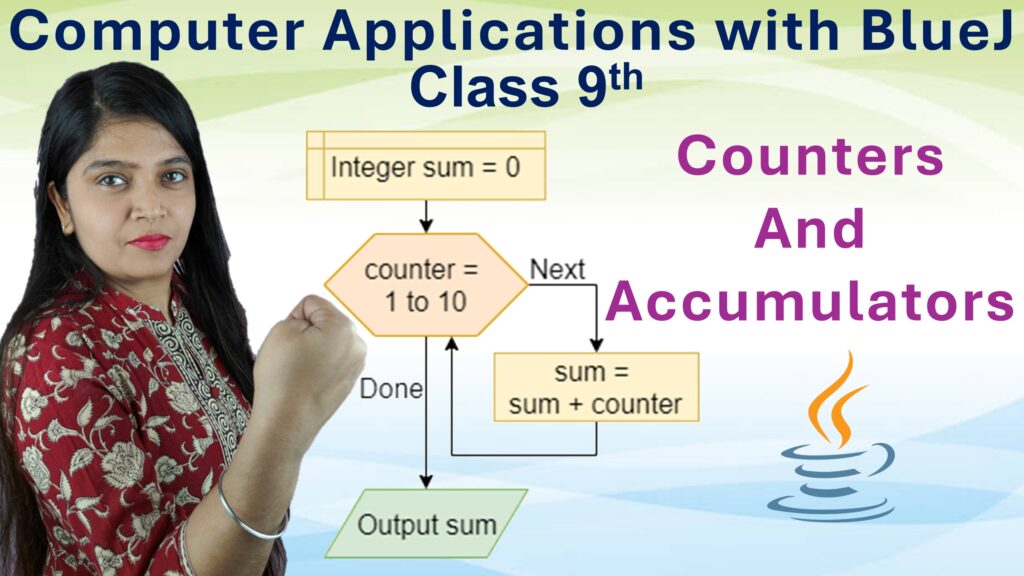Exercise: 1-C
Q1: Multiple Choice Type:
i. The number which on multiplying with \(5\frac{2}{3}\) gives \(-1\frac{2}{3}\) is:
Let the required number be \(x\)
We are given:
\[ x \times 5\frac{2}{3} = -1\frac{2}{3} \]
Convert mixed numbers to improper fractions:
\[ x \times \frac{17}{3} = \frac{-5}{3} \]
Now solve for \(x\):
\[ x = \frac{-5}{3} \div \frac{17}{3} \]
\[ x = \frac{-5}{3} \times \frac{3}{17} \]
\[ x = \frac{-15}{51} = \frac{-5}{17} \]
Correct Answer: (c) \(-\frac{5}{17}\)
ii. If a, b and c are three rational numbers, we have:
We apply the distributive property of multiplication over subtraction:
\[ a \times (b – c) = a \times b – a \times c \]
Correct Answer: (c)
iii. The product of a positive rational number and its reciprocal is:
Let the number be \(\frac{a}{b}\), where \(a > 0,\ b > 0\)
Then its reciprocal is \(\frac{b}{a}\)
Product:
\[ \frac{a}{b} \times \frac{b}{a} = \frac{ab}{ba} = 1 \]
Correct Answer: (c) 1
iv. The area of a rectangular paper is \(7\frac{1}{3}\) cm2. If its length \(4\frac{2}{5}\) cm, its breadth is:
Let breadth = \(x\)
Area = Length × Breadth
\[ 7\frac{1}{3} = 4\frac{2}{5} \times x \]
Convert mixed numbers to improper fractions:
\[ \frac{22}{3} = \frac{22}{5} \times x \]
Now solve for \(x\):
\[ x = \frac{22}{3} \div \frac{22}{5} = \frac{22}{3} \times \frac{5}{22} = \frac{5}{3} = 1\frac{2}{3} \text{ cm} \]
Correct Answer: (b) \(1\frac{2}{3}\) cm
v. The product of a rational number \(\frac{2}{7}\) and its additive inverse is:
Additive inverse of \(\frac{2}{7}\) is \(-\frac{2}{7}\)
\[ \frac{2}{7} \times \left(-\frac{2}{7}\right) = \frac{-4}{49} \]
Correct Answer: (b) \(-\frac{4}{49}\)
Q2: Evaluate
i. \(\frac{-14}{5}\times\frac{-6}{7}\)
Step-by-step:
\[ \frac{-14}{5} \times \frac{-6}{7} = \frac{(-14) \times (-6)}{5 \times 7} = \frac{84}{35} \]
Simplify:
\[ \frac{84}{35} = \frac{12}{5} \]
Answer: \(\frac{12}{5}\)
ii. \(\frac{7}{6}\times\frac{-18}{91}\)
Step-by-step:
\[ \frac{7}{6} \times \frac{-18}{91} = \frac{7 \times (-18)}{6 \times 91} = \frac{-126}{546} \]
Simplify:
Divide numerator and denominator by 42:
\[ \frac{-126 \div 42}{546 \div 42} = \frac{-3}{13} \]
Answer: \(\frac{-3}{13}\)
iii. \(\frac{-125}{72}\times\frac{9}{-5}\)
Step-by-step:
Two negatives make a positive:
\[ \frac{-125}{72} \times \frac{9}{-5} = \frac{125 \times 9}{72 \times 5} = \frac{1125}{360} \]
Simplify:
Divide numerator and denominator by 45:
\[ \frac{1125 \div 45}{360 \div 45} = \frac{25}{8} \]
Answer: \(\frac{25}{8}\)
iv. \(\frac{-11}{9}\times\frac{-51}{44}\)
Step-by-step:
Two negatives make a positive:
\[ \frac{-11}{9} \times \frac{-51}{-44} = \frac{-561}{396} \]
Simplify:
Divide numerator and denominator by 33:
\[ \frac{-561 \div 33}{396 \div 33} = \frac{-17}{12} \]
Answer: \(\frac{-17}{12}\)
v. \(-\frac{16}{5}\times\frac{20}{8}\)
Step-by-step:
\[ -\frac{16}{5} \times \frac{20}{8} = \frac{-320}{40} = -8 \]
Answer: \(-8\)
Q3: Multiply
i. \(\frac{5}{6}\ and\ \frac{8}{9}\)
Step-by-step:
\[ \frac{5}{6} \times \frac{8}{9} = \frac{5 \times 8}{6 \times 9} = \frac{40}{54} \]
Simplify:
\[ \frac{40}{54} = \frac{20}{27} \] (Divide both by 2)
Answer: \(\frac{20}{27}\)
ii. \(\frac{2}{7}\ and\ \frac{-14}{9}\)
Step-by-step:
\[ \frac{2}{7} \times \frac{-14}{9} = \frac{2 \times -14}{7 \times 9} = \frac{-28}{63} \]
Simplify:
\[ \frac{-28}{63} = \frac{-4}{9} \] (Divide both by 7)
Answer: \(\frac{-4}{9}\)
iii. \(\frac{-7}{8}\ and\ 4\)
Step-by-step:
\[ \frac{-7}{8} \times 4 = \frac{-7 \times 4}{8} = \frac{-28}{8} = \frac{-7}{2} \]
Answer: \(\frac{-7}{2}\)
iv. \(\frac{36}{-7}\ and\ \frac{-9}{28}\)
Step-by-step:
Two negatives make a positive:
\[ \frac{36}{-7} \times \frac{-9}{28} = \frac{36 \times 9}{7 \times 28} = \frac{324}{196} \]
Simplify:
Divide numerator and denominator by 4:
\[ \frac{324 \div 4}{196 \div 4} = \frac{81}{49} \]
Answer: \(\frac{81}{49}\)
v. \(\frac{-7}{10}\ and\ \frac{-8}{15}\)
Step-by-step:
\[ \frac{-7}{10} \times \frac{-8}{15} = \frac{56}{150} \]
Simplify:
\[ \frac{56}{150} = \frac{28}{75} \] (Divide by 2)
Answer: \(\frac{28}{75}\)
Q4: Evaluate
i. \(\left(\frac{2}{-3}\times\frac{5}{4}\right)+\left(\frac{5}{9}\times\frac{3}{-10}\right)\)
Step-by-step:
\[ \frac{2}{-3} \times \frac{5}{4} = \frac{-10}{12} = \frac{-5}{6} \]
\[ \frac{5}{9} \times \frac{3}{-10} = \frac{-15}{90} = \frac{-1}{6} \]
Now add both:
\[ \frac{-5}{6} + \frac{-1}{6} = \frac{-6}{6} = -1 \]
Answer: \(-1\)
ii. \(\left(2\times\frac{1}{4}\right)-\left(\frac{-18}{7}\times\frac{-7}{15}\right)\)
Step-by-step:
\[ 2 \times \frac{1}{4} = \frac{2}{4} = \frac{1}{2} \]
\[ \frac{-18}{7} \times \frac{-7}{15} = \frac{126}{105} = \frac{6}{5} \] (Simplified)
Now subtract:
\[ \frac{1}{2} – \frac{6}{5} = \frac{5 – 12}{10} = \frac{-7}{10} \]
Answer: \(\frac{-7}{10}\)
iii. \(\left(-5\times\frac{2}{15}\right)-\left(-6\times\frac{2}{9}\right)\)
Step-by-step:
\[ -5 \times \frac{2}{15} = \frac{-10}{15} = \frac{-2}{3} \]
\[ -6 \times \frac{2}{9} = \frac{-12}{9} = \frac{-4}{3} \]
Now subtract:
\[ \frac{-2}{3} – (\frac{-4}{3}) = \frac{-2}{3} + \frac{4}{3} = \frac{2}{3} \]
Answer: \(\frac{2}{3}\)
iv. \(\left(\frac{8}{5}\times\frac{-3}{2}\right)+\left(\frac{-3}{10}\times\frac{9}{16}\right)\)
Step-by-step:
\[ \frac{8}{5} \times \frac{-3}{2} = \frac{-24}{10} = \frac{-12}{5} \]
\[ \frac{-3}{10} \times \frac{9}{16} = \frac{-27}{160} \]
Now add:
Convert both to common denominator (LCM = 160):
\[ \frac{-12}{5} = \frac{-384}{160} \]
\[ \frac{-384}{160} + \frac{-27}{160} = \frac{-411}{160} \]
Answer: \(\frac{-411}{160}\)
Q5: Multiply each rational number, given below, by one (1):
i. \(\frac{7}{-5}\)
Step-by-step:
Any number multiplied by 1 gives the number itself:
\[
\frac{7}{-5} \times 1 = \frac{7}{-5}
\]
Answer: \(\frac{7}{-5}\)
ii. \(\frac{-3}{-4}\)
Step-by-step:
\[
\frac{-3}{-4} \times 1 = \frac{-3}{-4} = \frac{3}{4}
\] (Negative signs cancel)
Answer: \(\frac{3}{4}\)
iii. 0
Step-by-step:
Zero multiplied by any number is always zero:
\[
0 \times 1 = 0
\]
Answer: \(0\)
iv. \(\frac{-8}{13}\)
Step-by-step:
\[
\frac{-8}{13} \times 1 = \frac{-8}{13}
\]
Answer: \(\frac{-8}{13}\)
v. \(\frac{-6}{-7}\)
Step-by-step:
\[
\frac{-6}{-7} \times 1 = \frac{-6}{-7} = \frac{6}{7}
\] (Negative signs cancel)
Answer: \(\frac{6}{7}\)
Q6: For each pair of rational numbers. given below, verify that the multiplication is commutative:
i. \(\frac{-1}{5}\ and\ \frac{2}{9}\)
Check: \(\frac{-1}{5} \times \frac{2}{9} = \frac{2}{9} \times \frac{-1}{5}\)
LHS:
\[
\frac{-1}{5} \times \frac{2}{9} = \frac{-2}{45}
\]
RHS:
\[
\frac{2}{9} \times \frac{-1}{5} = \frac{-2}{45}
\]
Yes, multiplication is commutative.
ii. \(\frac{5}{-3}\ and\frac{13}{-11}\)
Check: \(\frac{5}{-3} \times \frac{13}{-11} = \frac{13}{-11} \times \frac{5}{-3}\)
LHS:
\[
\frac{5}{-3} \times \frac{13}{-11} = \frac{65}{33}
\]
RHS:
\[
\frac{13}{-11} \times \frac{5}{-3} = \frac{65}{33}
\]
Yes, multiplication is commutative.
iii. \(3\ and\frac{-8}{9}\)
Check: \(3 \times \frac{-8}{9} = \frac{-8}{9} \times 3\)
LHS:
\[
3 \times \frac{-8}{9} = \frac{-24}{9}
\]
RHS:
\[
\frac{-8}{9} \times 3 = \frac{-24}{9}
\]
Yes, multiplication is commutative.
iv. \(0\ and\frac{-12}{17}\)
Check: \(0 \times \frac{-12}{17} = \frac{-12}{17} \times 0\)
LHS:
\[
0 \times \frac{-12}{17} = 0
\]
RHS:
\[
\frac{-12}{17} \times 0 = 0
\]
Yes, multiplication is commutative.
Q7: Write the reciprocal (multiplicative inverse) of each rational number given below:
i. 5
Reciprocal of a number \(x\) is \(\frac{1}{x}\)
\[
\text{Reciprocal of } 5 = \frac{1}{5}
\]
Answer: \(\frac{1}{5}\)
ii. -3
\[
\text{Reciprocal of } -3 = \frac{1}{-3} = -\frac{1}{3}
\]
Answer: \(-\frac{1}{3}\)
iii. \(\frac{5}{11}\)
\[
\text{Reciprocal of } \frac{5}{11} = \frac{11}{5}
\]
Answer: \(\frac{11}{5}\)
iv. \(\frac{-7}{-8}\)
Note: \(\frac{-7}{-8} = \frac{7}{8}\) (negative signs cancel out)
\[
\text{Reciprocal of } \frac{7}{8} = \frac{8}{7}
\]
Answer: \(\frac{8}{7}\)
v. \(\frac{-8}{-7}\)
Note: \(\frac{-8}{-7} = \frac{8}{7}\)
\[
\text{Reciprocal of } \frac{8}{7} = \frac{7}{8}
\]
Answer: \(\frac{7}{8}\)
Q8: Find the reciprocal (multiplicative inverse) of:
i. \(\frac{3}{5}\times\frac{2}{3}\)
Step 1: Multiply the two rational numbers
\[
\frac{3}{5} \times \frac{2}{3} = \frac{3 \times 2}{5 \times 3} = \frac{6}{15} = \frac{2}{5}
\]
Step 2: Find the reciprocal of the product
\[
\text{Reciprocal of } \frac{2}{5} = \frac{5}{2}
\]
Answer: \(\frac{5}{2}\)
ii. \(\frac{-8}{3}\times\frac{13}{-7}\)
Step 1: Multiply the two rational numbers
\[
\frac{-8}{3} \times \frac{13}{-7} = \frac{-8 \times 13}{3 \times -7} = \frac{-104}{-21} = \frac{104}{21}
\]
Step 2: Find the reciprocal of the product
\[
\text{Reciprocal of } \frac{104}{21} = \frac{21}{104}
\]
Answer: \(\frac{21}{104}\)
iii. \(\frac{-3}{5}\times\frac{-1}{13}\)
Step 1: Multiply the two rational numbers
\[
\frac{-3}{5} \times \frac{-1}{13} = \frac{3 \times 1}{5 \times 13} = \frac{3}{65}
\]
Step 2: Find the reciprocal of the product
\[
\text{Reciprocal of } \frac{3}{65} = \frac{65}{3}
\]
Answer: \(\frac{65}{3}\)
Q9: Verify that \(\left(x+y\right)\times\ z=x\times\ z+y\times\ z\), if
i. \(x=\frac{4}{5},\ y=\frac{-2}{3}\ and\ z=-4\)
Step 1: Calculate LHS → \((x + y) \times z\)
\[
x + y = \frac{4}{5} + \left(\frac{-2}{3}\right) = \frac{4}{5} – \frac{2}{3}
\]
LCM of 5 and 3 = 15
\[
\frac{4}{5} = \frac{12}{15}, \quad \frac{2}{3} = \frac{10}{15}
\]
\[
x + y = \frac{12}{15} – \frac{10}{15} = \frac{2}{15}
\]
\[
(x + y) \times z = \frac{2}{15} \times (-4) = \frac{-8}{15}
\]Step 2: Calculate RHS → \(x \times z + y \times z\)
\[
x \times z = \frac{4}{5} \times (-4) = \frac{-16}{5}
\]
\[
y \times z = \frac{-2}{3} \times (-4) = \frac{8}{3}
\]
Now add the results:
\[
\frac{-16}{5} + \frac{8}{3}
\]
LCM = 15:
\[
\frac{-16}{5} = \frac{-48}{15}, \quad \frac{8}{3} = \frac{40}{15}
\]
\[
\frac{-48}{15} + \frac{40}{15} = \frac{-8}{15}
\]Answer: Verified, LHS = RHS = \(\frac{-8}{15}\)
ii. \(x=2\ ,\ y=\frac{4}{5}\ and\ z=\frac{3}{-10}\)
Step 1: Calculate LHS → \((x + y) \times z\)
\[
x + y = 2 + \frac{4}{5} = \frac{10}{5} + \frac{4}{5} = \frac{14}{5}
\]
\[
(x + y) \times z = \frac{14}{5} \times \left(\frac{-3}{10}\right) = \frac{-42}{50} = \frac{-21}{25}
\]Step 2: Calculate RHS → \(x \times z + y \times z\)
\[
x \times z = 2 \times \left(\frac{-3}{10}\right) = \frac{-6}{10} = \frac{-3}{5}
\]
\[
y \times z = \frac{4}{5} \times \left(\frac{-3}{10}\right) = \frac{-12}{50} = \frac{-6}{25}
\]
Now add the results:
\[
\frac{-3}{5} = \frac{-15}{25}
\]
\[
\frac{-15}{25} + \frac{-6}{25} = \frac{-21}{25}
\]Answer: Verified, LHS = RHS = \(\frac{-21}{25}\)
Q10: Verify that \(x\times\left(y-z\right)=x\times\ y-x\times\ z\), if
i. \(x=\frac{4}{5},\ y=\frac{7}{4}\ and\ z=3\)
Step 1: Calculate LHS → \(x \times (y – z)\)
\[
y – z = \frac{7}{4} – 3 = \frac{7}{4} – \frac{12}{4} = \frac{-5}{4}
\]
\[
x \times (y – z) = \frac{4}{5} \times \left(\frac{-5}{4}\right) = \frac{-20}{20} = -1
\]Step 2: Calculate RHS → \(x \times y – x \times z\)
\[
x \times y = \frac{4}{5} \times \frac{7}{4} = \frac{28}{20} = \frac{7}{5}
\]
\[
x \times z = \frac{4}{5} \times 3 = \frac{12}{5}
\]
\[
x \times y – x \times z = \frac{7}{5} – \frac{12}{5} = \frac{-5}{5} = -1
\]Answer: Verified, LHS = RHS = -1
ii. \(x=\frac{3}{4},\ y=\frac{8}{9}\ and\ z=-5\)
Step 1: Calculate LHS → \(x \times (y – z)\)
\[
y – z = \frac{8}{9} – (-5) = \frac{8}{9} + 5 = \frac{8}{9} + \frac{45}{9} = \frac{53}{9}
\]
\[
x \times (y – z) = \frac{3}{4} \times \frac{53}{9} = \frac{159}{36}
\]Step 2: Calculate RHS → \(x \times y – x \times z\)
\[
x \times y = \frac{3}{4} \times \frac{8}{9} = \frac{24}{36}
\]
\[
x \times z = \frac{3}{4} \times (-5) = \frac{-15}{4}
\]Now subtract:
\[
\text{Convert } \frac{-15}{4} = \frac{-135}{36}
\]
\[
x \times y – x \times z = \frac{24}{36} – \left(\frac{-135}{36}\right) = \frac{24 + 135}{36} = \frac{159}{36}
\]Answer: Verified, LHS = RHS = \(\frac{159}{36}\)
Q11: Name multiplication property of rational numbers shown below:
i. \(\frac{3}{5}\times\frac{-8}{9}=\frac{-8}{9}\times\frac{3}{5}\)
This shows that the order of multiplication does not affect the result.
Answer: Commutative Property of Multiplication
ii. \(\frac{-3}{4}\times\left(\frac{5}{7}\times\frac{-8}{15}\right)=\left(\frac{-3}{4}\times\frac{5}{7}\right)\times\frac{-8}{15}\)
This shows that how numbers are grouped (associativity) does not affect the product.
Answer: Associative Property of Multiplication
iii. \(\frac{4}{5}\times\left(\frac{3}{-8}+\frac{-4}{7}\right)=\frac{4}{5}\times\frac{3}{-8}+\frac{4}{5}\times\frac{-4}{7}\)
This shows that multiplication distributes over addition.
Answer: Distributive Property of Multiplication over Addition
iv. \(\frac{-7}{5}\times\frac{5}{-7}=1\)
The product of a number and its reciprocal is 1.
Answer: Multiplicative Inverse Property
v. \(\frac{8}{-9}\times1=1\times\frac{8}{-9}=\frac{8}{-9}\)
Multiplying any rational number by 1 leaves it unchanged.
Answer: Multiplicative Identity Property
Q12: Fill in the blanks:
i. The product of two positive rational numbers Is always ____________.
Answer: positive
ii. The product of two negative rational numbers Is always ____________.
Answer: positive
iii. If two rational numbers have opposite signs then their product is always ___________.
Answer: negative
iv. The reciprocal of a positive rational number is ____________ and the reciprocal of a negative rational number is __________.
Answer: positive, negative
v. Rational number 0 has ___________ reciprocal.
Answer: no
vi. The product of a non-zero rational number and its reciprocal is ___________.
Answer: 1
vii. The numbers ___________ and __________ are their own reciprocals.
Answer: 1 and -1
viii. If m is reciprocal of n, then the reciprocal of n is __________.
Answer: n
Q13: The length and breadth of a rectangular piece of paper are 9 cm and \(10\frac{2}{3} cm respectively. Find:
i. its area
Let length = \( 9 \) cm and breadth = \( 10\frac{2}{3} = \frac{32}{3} \) cm
Area of rectangle = Length × Breadth
\[
\text{Area} = 9 \times \frac{32}{3}
= \frac{9 \times 32}{3}
= \frac{288}{3}
= 96 \text{ cm}^2
\]Answer: Area = 96 cm²
ii. its perimeter
Perimeter of rectangle = \(2 \times (\text{Length} + \text{Breadth})\)
Length = 9, Breadth = \(\frac{32}{3}\)
\[
\text{Perimeter} = 2 \times \left(9 + \frac{32}{3}\right)
= 2 \times \left(\frac{27}{3} + \frac{32}{3}\right)
= 2 \times \frac{59}{3}
= \frac{118}{3}
= 39\frac{1}{3} \text{ cm}
\]Answer: Perimeter = \(39\frac{1}{3}\) cm
Q14: Find the area and the perimeter of a rectangular piece of land with length \(7\frac{2}{5}\) m and breadth \(4\frac{1}{6}\) m.
i. AreaConvert the mixed numbers to improper fractions:
Length = \(7\frac{2}{5} = \frac{37}{5}\) m
Breadth = \(4\frac{1}{6} = \frac{25}{6}\) m
Area = Length × Breadth
\[ \text{Area} = \frac{37}{5} \times \frac{25}{6} = \frac{925}{30} = \frac{185}{6} \text{ m}^2 = 30\frac{5}{6} \text{ m}^2 \]Answer: Area = \(30\frac{5}{6}\) m²
ii. Perimeter
Perimeter = \(2 \times ( \text{Length} + \text{Breadth} )\)
\[ \text{Length} + \text{Breadth} = \frac{37}{5} + \frac{25}{6} = \frac{(37 \times 6 + 25 \times 5)}{30} = \frac{222 + 125}{30} = \frac{347}{30} \]\[ \text{Perimeter} = 2 \times \frac{347}{30} = \frac{694}{30} = \frac{347}{15} = 23\frac{2}{15} \text{ m} \]Answer: Perimeter = \(23\frac{2}{15}\) m







Leave a Comment